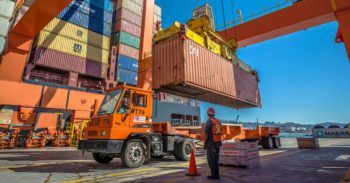
As the port industry strives to make the terminals of the future safe, cost efficient and fully automated, the vision of “a zero accident port is definitely a mission possible,” according to Finnish port equipment manufacturer Kalmar.
There is always a risk of human error and accidents when people interact with equipment that carries heavy goods. Automation decouples humans and machines. Machines detect their surroundings and notice things that human eyes and ears might not, thus helping humans to prevent accidents.
“Automation enables both machines and humans to concentrate on what they are good at. The human mind is superior in terms of planning, innovation and perception,” Frank Kho, Vice President of Market Intelligence, Strategy and Development at Kalmar, said.
But will these fully automated terminals of the future still need humans? Kho said that large terminal areas can already function completely unmanned, however, “they can never be entirely staffless. Human intervention is crucial.”
Humans will work side-by-side with intelligent robots and other automated equipment as machines cannot be programmed for unexpected events, such as a bad storm at sea which might cause the cargo to shift or some containers to leak.
There is always something that requires specialised handling and lifting equipment and often also special storage facilities. Kho notes that terminals can become staffless only if the shipping industry can standardise everything and terminals can be turned into production lines.
“That will never happen. This is something that engineers can forget when they develop technological solutions. The real world can’t be completely standardised,” according to Kho.
He notes that today, terminals still rely heavily on humans interacting with each other via walkie-talkies. The majority of processes are unwritten and undefined, with experienced staff knowing everything by heart. But with automation, each and every move must be planned, prepared and programmed.
“Every step towards automation improves safety. And improved safety in turn reduces number of lost working hours, equipment damage costs and insurance premiums.”
The crucial notion to consider on the path to fully automated terminals is change management. Early planning, training and continuous open communication with employees, trade unions and other stakeholders is vital.
“Automation will require a whole new set of skills and change of mindset in everyone working at a terminal,” Kalmar said, adding that, in the end, the result “can be zero accidents.”
Copyright Ships & Ports Ltd. Permission to use quotations from this article is granted subject to appropriate credit given to www.shipsandports.com.ng as the source.